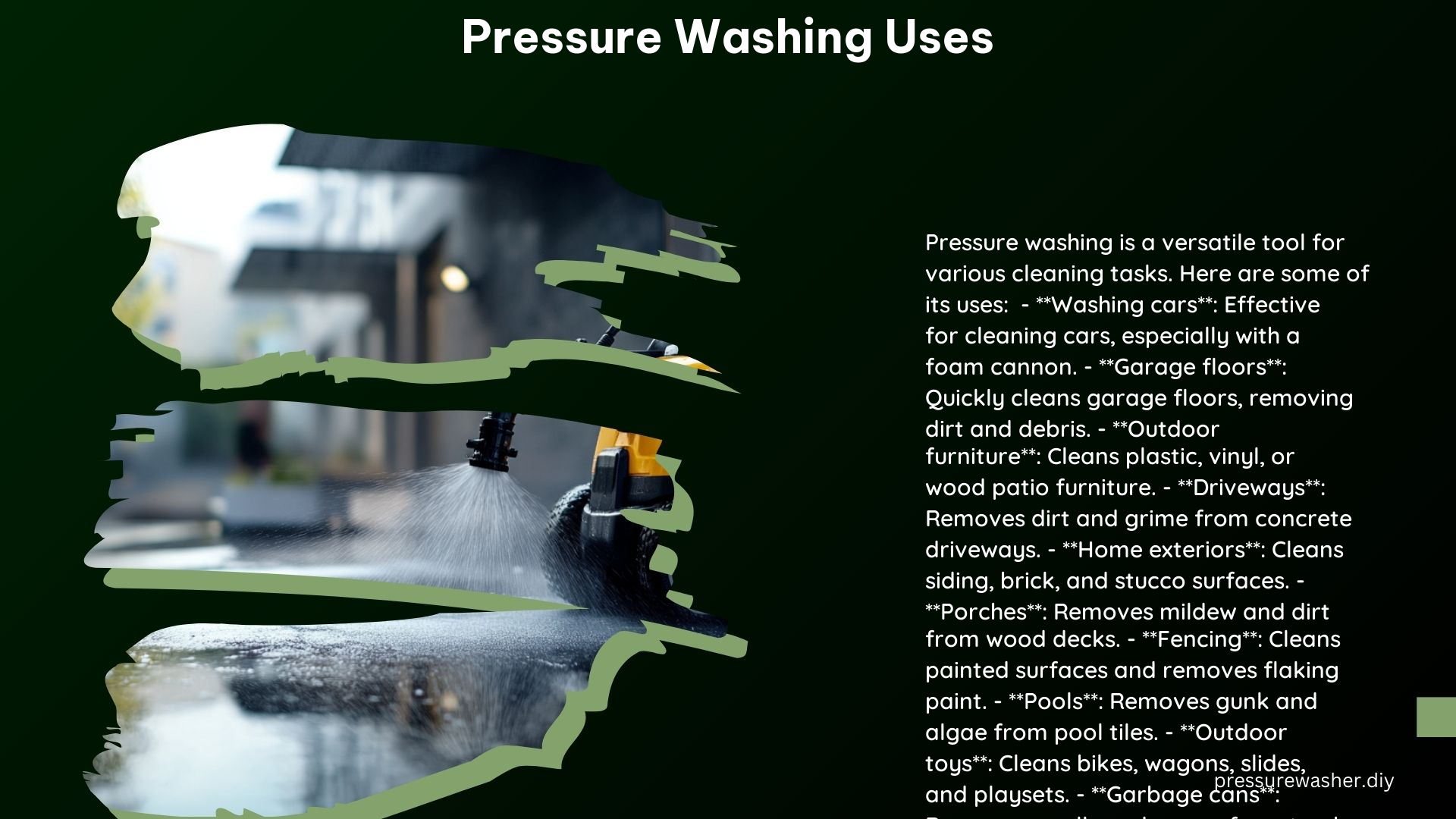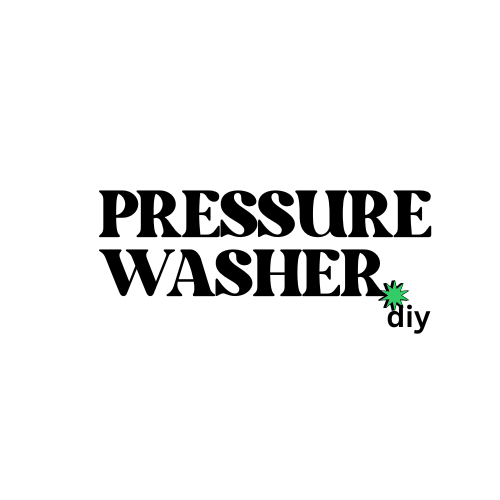Pressure washing is a versatile and effective method for cleaning various surfaces, offering a wide range of uses for both residential and commercial applications. From cleaning driveways and home exteriors to maintaining outdoor furniture and prepping surfaces for painting, pressure washers can tackle a variety of cleaning tasks with ease. In this comprehensive guide, we’ll explore the technical specifications, safety precautions, and best practices for utilizing pressure washers to their full potential.
Driveways and Sidewalks
Pressure washers are an excellent tool for cleaning driveways and sidewalks, removing stubborn dirt, grime, and mildew that can accumulate over time. The typical pressure range for cleaning concrete surfaces is between 1,500 to 3,000 PSI, with a flow rate of 2 to 4 GPM. Using a 25-degree or 40-degree nozzle, you can effectively clean these surfaces, restoring their appearance and preventing further damage.
Home Exteriors

Pressure washing can transform the look of your home’s exterior by removing dirt, mildew, and other contaminants from vinyl siding, brick, and stucco. The recommended pressure range for home exteriors is typically between 1,200 to 1,900 PSI, with a flow rate of 2 to 4 GPM. Using a wide-angle nozzle, you can efficiently clean large surface areas without causing damage.
Decks and Patios
Pressure washers are an excellent tool for cleaning decks, patios, and other outdoor living spaces. The recommended pressure range for these surfaces is between 500 to 1,200 PSI, with a flow rate of 2 to 4 GPM. Using a 25-degree or 40-degree nozzle, you can effectively remove dirt, mildew, and algae, restoring the natural beauty of your outdoor spaces.
Garage Floors
Pressure washing is an effective way to clean garage floors, removing dirt, oil stains, and other substances that can make the floor slippery and difficult to clean. The recommended pressure range for garage floors is between 1,500 to 3,000 PSI, with a flow rate of 2 to 4 GPM. Using a 15-degree or 25-degree nozzle, you can effectively clean the floor and prepare it for any necessary sealant or coating.
Outdoor Furniture
Pressure washers can be used to clean outdoor furniture, including plastic, vinyl, and wood pieces, to remove dirt and grime that can accumulate on these surfaces. The recommended pressure range for outdoor furniture is between 500 to 1,200 PSI, with a flow rate of 2 to 4 GPM. Using a wide-angle nozzle, you can efficiently clean these surfaces without causing damage.
Cars and Vehicles
Pressure washers are commonly used to clean cars, trucks, and other vehicles, removing dirt, grime, and other substances that can damage the paint or other surfaces. The recommended pressure range for vehicle cleaning is between 1,200 to 1,900 PSI, with a flow rate of 2 to 4 GPM. Using a 25-degree or 40-degree nozzle, you can effectively clean the vehicle’s exterior without causing any harm.
Gutters and Downspouts
Pressure washing can be used to clean gutters and downspouts, removing debris and dirt that can clog these systems and cause water damage. The recommended pressure range for this task is between 1,500 to 3,000 PSI, with a flow rate of 2 to 4 GPM. Using a narrow-angle nozzle, you can effectively clean these hard-to-reach areas.
Pools and Pool Decks
Pressure washers can be used to clean pool surfaces, removing dirt and algae that can accumulate on the walls and floor of the pool. The recommended pressure range for pool cleaning is between 1,200 to 1,900 PSI, with a flow rate of 2 to 4 GPM. Using a wide-angle nozzle, you can efficiently clean the pool surfaces without causing any damage.
Outdoor Toys and Equipment
Pressure washers can be used to clean outdoor toys, bicycles, and other equipment, removing dirt and grime that can accumulate on these surfaces. The recommended pressure range for this task is between 500 to 1,200 PSI, with a flow rate of 2 to 4 GPM. Using a wide-angle nozzle, you can effectively clean these items without causing any damage.
Garbage Cans
Pressure washing can be used to clean garbage cans, removing dirt, grime, and odors that can accumulate on these surfaces. The recommended pressure range for this task is between 1,200 to 1,900 PSI, with a flow rate of 2 to 4 GPM. Using a narrow-angle nozzle, you can effectively clean the interior and exterior of the garbage can, ensuring a fresh and clean appearance.
Fabric and Rugs
Pressure washers can be used to clean outdoor fabrics and rugs, removing dirt and stains that can accumulate on these surfaces. The recommended pressure range for this task is between 500 to 1,200 PSI, with a flow rate of 2 to 4 GPM. Using a wide-angle nozzle and a gentle cleaning solution, you can effectively clean these delicate surfaces without causing any damage.
Brick Patios and Walkways
Pressure washing can be used to clean brick patios and walkways, removing dirt and grime that can accumulate on these surfaces. The recommended pressure range for this task is between 1,500 to 3,000 PSI, with a flow rate of 2 to 4 GPM. Using a 25-degree or 40-degree nozzle, you can effectively clean the brick surfaces, restoring their natural appearance.
Composite Decking
Pressure washers can be used to clean composite decking, removing dirt and grime that can accumulate on these surfaces. The recommended pressure range for this task is between 500 to 1,200 PSI, with a flow rate of 2 to 4 GPM. Using a wide-angle nozzle and a gentle cleaning solution, you can effectively clean the composite decking without causing any damage.
Painted Railings
Pressure washing can be used to clean painted railings, removing dirt and grime that can accumulate on these surfaces. The recommended pressure range for this task is between 1,200 to 1,900 PSI, with a flow rate of 2 to 4 GPM. Using a 25-degree or 40-degree nozzle, you can effectively clean the painted railings without causing any damage to the paint.
Stone Patios
Pressure washers can be used to clean stone patios, removing dirt and grime that can accumulate on these surfaces. The recommended pressure range for this task is between 1,500 to 3,000 PSI, with a flow rate of 2 to 4 GPM. Using a 25-degree or 40-degree nozzle, you can effectively clean the stone surfaces, restoring their natural appearance.
Wood Outdoor Showers
Pressure washing can be used to clean wood outdoor showers, removing dirt and grime that can accumulate on these surfaces. The recommended pressure range for this task is between 500 to 1,200 PSI, with a flow rate of 2 to 4 GPM. Using a wide-angle nozzle and a gentle cleaning solution, you can effectively clean the wood surfaces without causing any damage.
Outdoor Tile
Pressure washers can be used to clean outdoor tile, removing dirt and grime that can accumulate on these surfaces. The recommended pressure range for this task is between 1,200 to 1,900 PSI, with a flow rate of 2 to 4 GPM. Using a 25-degree or 40-degree nozzle, you can effectively clean the tile surfaces, restoring their clean and polished appearance.
Fencing
Pressure washing can be used to clean fencing, removing dirt and grime that can accumulate on these surfaces. The recommended pressure range for this task is between 1,200 to 1,900 PSI, with a flow rate of 2 to 4 GPM. Using a 25-degree or 40-degree nozzle, you can effectively clean the fencing, improving its overall appearance.
Prepping for Painting
Pressure washers can be used to clean surfaces before painting, removing dirt and grime that can affect the adhesion of paint. The recommended pressure range for this task is between 1,200 to 1,900 PSI, with a flow rate of 2 to 4 GPM. Using a wide-angle nozzle, you can effectively clean the surface, ensuring a smooth and even paint application.
Front Entrance Stairs and Walkways
Pressure washing can be used to clean front entrance stairs and walkways, improving curb appeal and removing dirt and grime that can accumulate on these surfaces. The recommended pressure range for this task is between 1,500 to 3,000 PSI, with a flow rate of 2 to 4 GPM. Using a 25-degree or 40-degree nozzle, you can effectively clean these high-traffic areas, restoring their clean and inviting appearance.
Remember, when using a pressure washer, it’s essential to follow safety precautions, such as wearing protective gear, starting with low pressure, and avoiding high pressure on sensitive surfaces. By understanding the technical specifications and best practices for pressure washing, you can effectively and safely tackle a wide range of cleaning tasks around your home or business.
References
- Reddit. (2018). Do you find a pressure washer useful? Retrieved from https://www.reddit.com/r/HomeImprovement/comments/9k6s0g/do_you_find_a_pressure_washer_useful/
- Giraffe Tools. (2023). 22 Uses for a Pressure Washer: Simple Hacks You’ve Never Thought Of. Retrieved from https://giraffetools.com/blogs/news/22-uses-for-a-pressure-washer-simple-hacks-youve-never-thought-of
- Pressure Washers Direct. (n.d.). Over 25 Ways to Use a Pressure Washer at Home. Retrieved from https://www.pressurewashersdirect.com/stories/1819-How-to-Use-a-Pressure-Washer-At-Home.html
- Young House Love. (2022). A Beginner’s Guide To Pressure Washing. Retrieved from https://www.younghouselove.com/pressure-washing-101-beginners-guide/
- House Beautiful. (2021). 10 Things You Should Be Cleaning With Your Pressure Washer. Retrieved from https://www.housebeautiful.com/lifestyle/cleaning-tips/a37595659/pressure-washer-tips/
